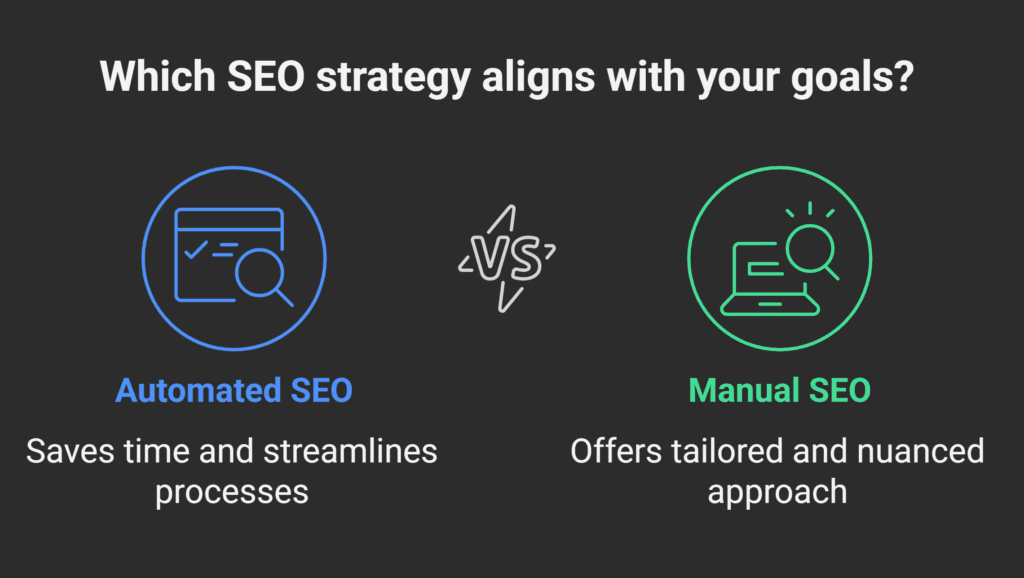Want to grow your website traffic but hate the boring, repetitive SEO tasks?
You’re not alone!
Learning how to automate your SEO is like hiring a robot to do your SEO Tasks Faster.
This beginner’s guide breaks down the easiest ways to save time, avoid mistakes, and keep Google happy. Whether you’re running a blog, online store, or small business, automation tools make SEO simpler.
Let’s dive in!


Get your free SEO Score
What is SEO Automation?

Before we dive in, let’s quickly clarify what SEO automation means.
This can save you time and help you focus on the more creative aspects of your website.
SEO automation means that instead of checking your website every day or finding keywords manually use the right tools to find keywords in a couple of seconds.
In short:
SEO automation = Using tools to save time and get better results.
For example, Semrush and Ahrefs can find the best keywords for you without manual work.
Why Automate Your SEO? Big Benefits You Should Know

Here’s how automation makes your work easier:
🕒 1. Save Time
SEO takes a lot of time if you do it by yourself.
But with automation tools, you can:
- Track keywords in seconds
- Run site audits quickly
- Get reports without typing anything
Now, you can spend time on other important things.
❌ 2. Avoid Mistakes
Humans make mistakes. You may miss a broken link or write the wrong title.
Automation tools check your site for:
- Broken links
- Missing meta tags
- Slow-loading pages
This keeps your site clean and safe for users.
📅 3. Stay On Schedule
Google likes websites that stay fresh. It helps your site rank higher.
With automation, you can:
- Post new content on time
- Update pages quickly
- Fix problems fast
That keeps both Google and your readers happy.
📈 4. Track What Works
Do you know which blog post got the most clicks? Or what keywords bring traffic?
Automation tools give you:
- Easy-to-read reports
- Traffic insights
- Keyword rankings
Now, you can make smart moves based on real data.
🔁 5. Keep SEO Going 24/7
You can’t work all day, but your tools can! Automated SEO runs while you sleep.
This means:
- Round-the-clock tracking
- Alerts if something breaks
- Backups and checks, always running
🎯 6. Focus on Big Wins
When tools do the small jobs, you can:
- Plan smart strategies
- Build better content
- Get more traffic and leads
What SEO Tasks Can You Actually Automate? (and the Tools That Help)
Automating SEO tasks saves time, reduces errors, and lets you focus on strategy.
Here’s a breakdown of SEO processes you can automate and the tools to get the job done:
1. Keyword Tracking

Manually tracking keyword rankings is time-consuming. Automation tools check your rankings daily across search engines and show trends.
Tools to use:
- SEMrush (daily rank tracking)
- Ahrefs (keyword monitoring)
- Multiple Keyword Position Checker (free bulk keyword tracking)
2. Site Health Checks (Technical SEO Audits)

Technical issues like broken links, slow pages, or missing metadata hurt rankings. Automated crawlers scan your site and flag errors.
Tools to use:
- Screaming Frog (free/paid crawling)
- SEMrush Site Audit
- Ahrefs Site Audit
- Robots.txt Generator (create error-free robots.txt files)
Common problems detected:
- Broken links (404 errors)
- Missing title tags or meta descriptions
- Large images (>100 KB) without alt tags
- Non-mobile-friendly pages
3. Keyword Research
Tools generate keyword ideas, search volume, and competition data, so you don’t have to brainstorm alone.
Tools to use:
- Google Keyword Planner (free)
- Long-Tail Keyword Finder (discovers niche phrases)
- SEMrush Keyword Magic Tool
4. Backlink Monitoring
Tracking who links to your site (or stops linking) manually is impossible. Automation tools alert you to changes in your backlink profile.
Tools to use:
- Ahrefs Backlink Checker
- Moz Link Explorer
- Link Tracking Tool (monitors backlink health)
5. On-Page SEO Optimisations
6. Reporting
Automated reports pull data from Google Analytics, Search Console, and rank trackers into one dashboard.
7. Schema Markup Implementation
Schema helps Google understand your content. Plugins auto-generate code for products, FAQS, or articles.
Tools to use:
By using tools like SEMrush for audits, Ahrefs for keywords, and specialised free tools like the Multiple Keyword Position Checker, you can automate your routine SEO tasks.
Pro Tip: Combine free and paid tools to balance cost and functionality. For example, use Screaming Frog (free) for site crawls and SEMrush (paid) for content optimisation.
Here’s a quick table showing how automation changes things for some common tasks:
Task | Manual Way (The Hard Way!) | Automated Way (The Smart Way!) | Benefits of Automation |
Rank Tracking | Search Google for each keyword, and record the rank | Tool checks rankings daily/weekly, provides a report | Saves huge amounts of time, spots trends |
Site Audit | Click every link, check every page’s code | Tool crawls site, lists all technical errors | Finds hidden issues fast, comprehensive |
Backlink Check | Guess who links to you? Search randomly? | Tool monitors links, alerts you to changes | Tracks profile accurately, competitor insights |
Reporting | Copy/paste data from 5 different places | Tool pulls data into one dashboard/report | Saves time, easier data overview |
See? Automation takes the repetitive, time-consuming parts and just… does them.
Your Beginner’s Guide to SEO Automation Tools (Free + Paid Options)
1. All-in-One SEO Suites
These platforms handle multiple tasks (keyword research, audits, rank tracking) in one place:
2. Keyword Research & Tracking Tools
Find high-value keywords and track rankings effortlessly:
Google Keyword Planner: Free tool for keyword ideas and search volume estimates.
Long-Tail Keyword Finder: Discover low-competition phrases for niche targeting.
Multiple Keyword Position Checker: Track rankings for hundreds of keywords in seconds.
3. Technical SEO & Site Audits
Fix website errors and improve technical health:
Screaming Frog SEO Spider: Crawls your site to find broken links, duplicates, and more. The free version scans 500 URLS.
Robots.txt Generator: Create error-free robots.txt files to control search engine access.
Google Search Console: A Free tool to monitor indexing, keywords, and technical issues.
4. Rank Tracking & Backlink Management
Monitor performance and track competitor links:
Link Tracking Tool: Track backlinks and identify spammy or lost links.
Google Analytics: Measure traffic sources, user behaviour, and conversions.
5. WordPress SEO Plugins
6. AI-Powered SEO Assistants
Leverage AI for content ideas and strategy:
ChatGPT: Generate SEO-friendly content outlines, meta descriptions, and FAQs.
Perplexity.ai: Research topics and find data-backed keywords quickly.
Gemini (Google AI): Analyse trends and get content recommendations.
Pro Tip: Combine AI tools like ChatGPT with SEO suites like Semrush for faster content creation and optimisation!
Ready to automate? Start with free tools and scale up as your needs grow. Consistency + the right tools = SEO success! 🚀
Beginner’s Guide to SEO Automation: A 5-Step Plan (Easy & Effective)

If you’re new to SEO, automation can save time, reduce errors, and help you focus on strategy. Here’s a simple, actionable plan to start automating SEO tasks without overwhelm.
Step 1: Identify Repetitive Tasks
Start by listing SEO tasks that eat up your time. Common examples:
Checking keyword rankings.
Scanning for broken links.
Auditing site health (e.g., page speed, mobile friendliness).
Tracking competitor keywords.
Pro Tip: Beginners often start with rank tracking or site audits. These are easy to automate and provide quick wins.
Step 2: Focus on One Task to Automate First
Don’t automate everything at once. Pick one task that’s either:
Most time-consuming (e.g., daily keyword checks).
Easiest to automate (e.g., weekly broken-link scans).
Example: Set up automated rank tracking for 5–10 priority keywords.
Step 3: Choose the Right Tools (Free or Affordable)
Use reliable, beginner-friendly tools. Start with free options:
Google Tools: Google Analytics, Search Console, Keyword Planner.
Site Audits: Screaming Frog (free version), Sitechecker.
Rank Tracking: Ubersuggest, Semrush (free trial).
SEO Plugins: Yoast SEO, Rank Math (for WordPress).
Why This Works: Free tools minimise risk while you learn.
Step 4: Learn the Tool’s Basics
Spend 1–2 hours understanding your chosen tool:
Watch tutorials (YouTube or tool-specific guides).
Learn key settings (e.g., crawl limits, keyword filters).
Practice generating reports.
Key Question: “What data does this tool provide, and how can I use it?”
Step 5: Automate, Monitor & Improve
Set up automation (e.g., weekly site crawls) but review results regularly:
Is the tool working correctly?
Are reports actionable? (e.g., fixing broken links).
Adjust settings as needed (e.g., adding new keywords).
Golden Rule: Automation ≠ “set and forget.” Review data monthly.
Why Trust This Approach?
This guide is based on 2+ years of SEO experience, testing tools like Screaming Frog and Semrush. Recommendations prioritize:
Ease of Use: Tools with intuitive dashboards.
Cost-Effectiveness: Free or budget-friendly options.
Accuracy: Reliable data for informed decisions.
Next Steps
Once you’ve automated one task, repeat the process. For example:
After rank tracking, automate site health checks.
Then, schedule broken-link scans.
Final Tip: Start small. Automation is a marathon, not a sprint.
Why This Works for Beginners:
Simple Language: Avoids jargon.
Actionable Steps: Clear, step-by-step process.
Trustworthy Tools: Recommends industry-tested resources.
By following this plan, you’ll save hours, reduce manual work, and build a stronger SEO foundation.
Conclusion
SEO doesn’t have to be hard or time-consuming. With the right tools, even beginners can automate keyword tracking, site audits, backlink monitoring, and more.
This lets you spend less time on repetitive tasks and more time on building great content and strategies that work.
Remember: Automation = Efficiency. Strategy = Results.
Want to grow your website traffic but hate the boring, repetitive SEO tasks?
You’re not alone!
Learning how to automate your SEO is like hiring a robot to do your SEO Tasks Faster.
This beginner’s guide breaks down the easiest ways to save time, avoid mistakes, and keep Google happy. Whether you’re running a blog, online store, or small business, automation tools make SEO simpler.
Let’s dive in!






